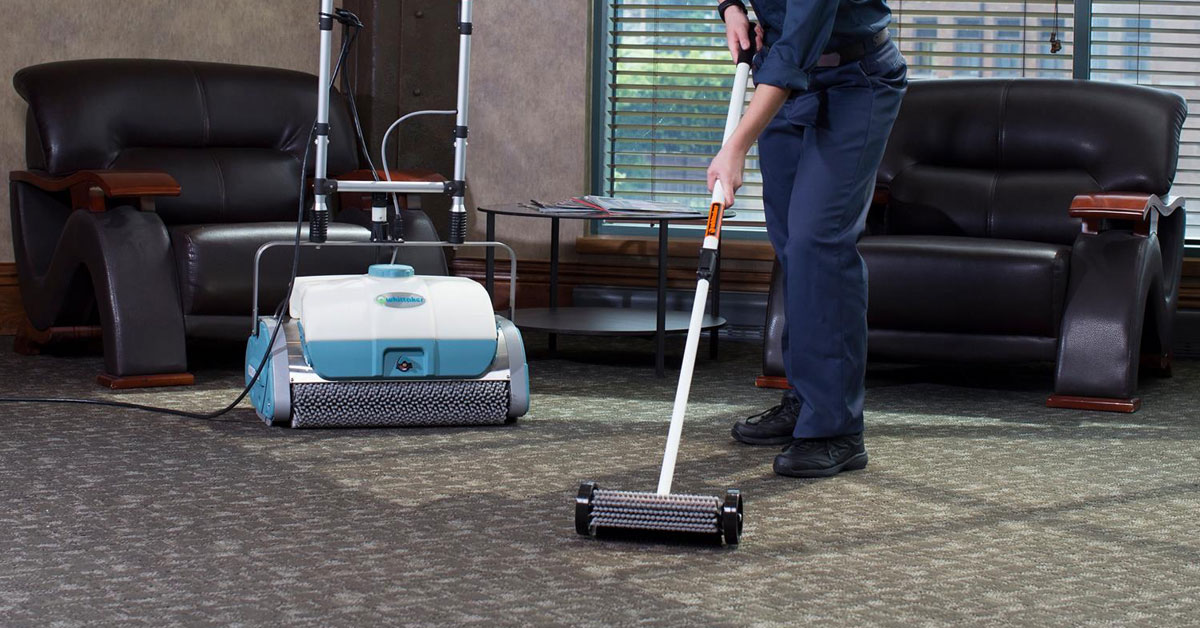From office buildings to airports to retail stores, building service contractors (BSCs) are responsible for keeping numerous facilities clean. Floors are often the first thing that building occupants and visitors see when entering, so it’s important that they make the right impression. Clean carpet is welcoming and an expectation that must be met every day at every customer site.
In today’s increasingly competitive marketplace, BSCs must do everything in their power to improve their service while also finding ways to differentiate their business. Having the right carpet cleaning equipment and tools on hand is key for delivering superior results that leads to customer retention. BSCs should understand the various types of carpet cleaning machines and ideal features that support carpet cleanliness to ensure 5-star reviews and earn new business.
Numerous Carpet Cleaning Options to Consider
It can seem overwhelming to choose the right machine or machines to support interim and restorative carpet maintenance. Here is a helpful breakdown of options available to BSCs:
- Low-moisture encapsulation equipment – Using too much moisture during the carpet cleaning process results in long drying times and can even accelerate the growth of mold and mildew. Interim carpet maintenance equipment that relies on encapsulation to capture soils is ideal because of its low moisture approach. It removes dirt from the top fibers of carpet as well as those captured deep within fibers. BSCs should confirm that a machine is lightweight, offers intuitive controls, a machine-mounted solution tank and ideally integrated landing gear to protect brushes. Today, there are two- and three-brush machines available that can quickly clean large carpeted areas.
- Truck-mounted system – There are many options for professional grade truck-mounted systems for carpet cleaning. These can provide a more thorough clean than portable equipment, especially the types of machines available to consumers. BSCs interested in truck-mounted systems should look for one that is easy to set up, features automatic water refill for continuous use, offers high pressure levels and a large recovery tank. It’s important to note that high-rise buildings can present a challenge for truck-mounted systems.
- Rotary floor machines – Bonnet cleaning is an interim carpet maintenance strategy that was once more widely used than it is today. One reason for the shift to other processes is that bonnet cleaning only changes the appearance of the top of the carpet fibers. It cannot penetrate deep into carpet fibers to provider a more thorough clean. This strategy uses a rotary floor machine with a pad that absorbs dirt. However, misuse can create added wear on carpets and some argue that the high-speed rotation actually pushes soil into carpet fibers, making them appear dirty more quickly. In addition to requiring a higher skill level user, rotary floor machine also void most carpet manufacturer’s warranties.
Thankfully, the Carpet and Rug Institute (CRI) also maintains an updated list of certified deep cleaning systems. BSCs should consider this a starting point in the search for the right equipment. BSCs should also take into account the total cost of ownership when making a purchase. While some equipment may have a higher upfront cost, it can result in a better clean, allow employees to clean more efficiently, and even be more durable over the long term.
Best Practices for Maintaining your Machine
The work isn’t over once a BSC finds the right machine. Ongoing care and maintenance are essential for keeping equipment in good working order. When machines aren’t functioning, the downtime results in service interruption, lapses in cleanliness and even customer complaints that can put an account in jeopardy.
BSCs should consider these best practices for carpet cleaning machine maintenance:
- Maintain the machine after carpet cleaning is complete. This may include emptying a solution tank and collection tray to make sure it is clean for the next use, as well as rotating brushes.
- Regularly flush spray nozzles with water to avoid clogging. This ensures that the chemistry is consistently applied on carpet.
- Wipe down and wind the power cable to avoid tangling and damage.
- For the best cleaning results, replace necessary components as they wear, such as brushes.
Consistently Clean Carpet
There are numerous types of carpet cleaning machines available to building service contractors. These include low-moisture encapsulation equipment, truck-mounted systems and rotary floor machines. Equipment should be viewed as a long-term investment in the business. Carefully vetting the various options is crucial, as not every type or model is recommended by leading carpet mills and the CRI.
Selecting easy-to-use equipment that’s proven to reliably remove stains will help BSCs improve their carpet cleaning offering. Additionally, using trusted machines will limit damage to carpet fibers, thereby prolonging the lifespan of the flooring investment.
It’s also important to work with a manufacturer that can offer effective stain removal chemistry in addition to machines. The right partner should also offer carpet cleaning expertise and reliable service and support in the event that machines need maintenance.

